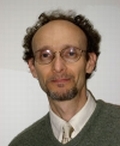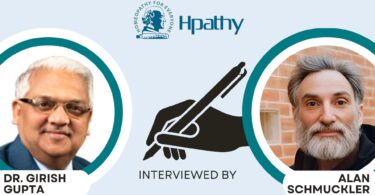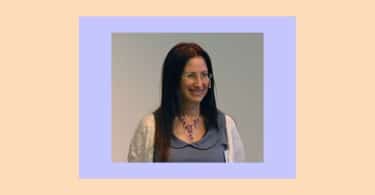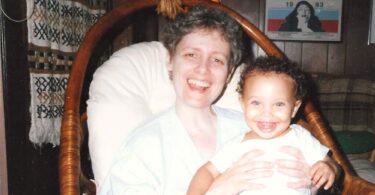Homeopath Julian Jonas has served as an instructor at the New England School for Homeopathy, the Finger Lakes School for Homeopathy, the Teliosis School of Homeopathy, the North East College of Healing Arts and Science and the New England School for Acupuncture. He’s written many articles on healthcare, some of which are reprinted in our journal.
AS: Welcome to Hpathy, Julian, it’s a pleasure to have you with us today. You’ve been involved in natural healthcare for over 25 years. What was your path to homeopathy?
JJ: There’s a short and a long answer. 
The longer answer is that I was born into a medical family that lived in a small town in southern New Jersey that, believe it or not was still mostly racially segregated in the 1950’s. My mother was a nurse and my father an old time GP, who during my childhood made house calls, hospital visits and had an office next to the house. My job as a child was to turn the lights on in the office and porch for evening hours. Often I accompanied him on house calls and hospital rounds.
He had no secretaries, no nurses. It was just a solo practice, unimaginable in today’s world. Although he was strictly an allopath, the type of care and involvement he modeled for me has had a profound influence. He died when I was still a child, and one my strongest memories is the overflow crowd of people – rich, poor, black, white – who attended the funeral.
I ended up in a New York suburban environment, an affluent Jewish community, where the pressure to achieve the status of being a doctor or lawyer was ever present. It being the 1960’s, I wanted nothing to do with that.
Constitutionally I was not a strong person and together with poor lifestyle choices during my teens and into college (remember it was the 60’s and 70’s), I’d become quite unhealthy. Visits to allopaths proved fruitless and only served to reinforce my distaste for the profession.
I needed to find my own path toward health, and by extension, my own path toward helping others heal. It’s an ongoing project with many twists and turns including a decade in Asia where I pursued a degree in Oriental Medicine, had my own practice, and spent a few years working as a practitioner in a remote jungle area. After returning to the US in the mid 80’s, I became reinfected by the homeopathy bug and pursued a total retooling of my skills to become a homeopath. The journey continues.
AS :Your dad was a very special role model, a kind that doesn’t exist anymore in the U.S. You survive the 60’s, turn your liabilities into assets and end up in Asia… a far cry from New York. Can you share at least one adventure with us?
JJ: The first adventure that comes to mind is the birth of our oldest child in December of 1984. My wife Kazuko and I had left Japan about three months earlier, first to India where we divided our time between meditating and traveling, and then onto Sri Lanka, where I had already laid the groundwork for a rural health project treating villagers in a remote area with acupuncture.
Not long after arriving in Sri Lanka, Kazuko became, shall we say, ‘emotionally labile’ and hypersensitive to smells. A pregnancy and birth were not on the agenda, but we were forced to decide whether to end our adventure and return to Japan for the birth, or have the child where we were.
Our decision was basically made for us when we were introduced to a wonderful midwife who had learned from her own mother some 40 years earlier and had given birth to 11 children herself. She was also the widow of a physician – and inherited his little black doctor’s bag, competently employing many medical procedures.
Both of us felt very comfortable with her, but there were a few items we had to negotiate. First, she had grown used to doing an episiotomy to make for an easier birth and reduce the chance of severe bleeding. Kazuko and I were pretty adamant about not wanting that, so she relented.
More difficult to negotiate was my presence at the birth. In her experience, men in general, and husbands in particular, were too squeamish to attend a home birth and it made her life much easier to categorically exclude them. After some discussion on the point, it dawned on me that I held the trump card: if I wasn’t around, there would be no one to translate to Japanese. So, she resignedly relented on that count, too.
We planned to have the birth in a room at the clinic I had set up for the project. The clinic itself was in a large house where we lived with the owners. Interestingly, our plans engendered the enmity of local medical authorities because they were actively trying to ‘educate’ the women to give birth in a hospital and here we were, quite visible representatives of ‘modern’ westerners, basically repudiating the entire concept by having a home birth with a traditional midwife.
Thereafter, we were frequently visited by young women who were designated as ‘midwifes’, but who were in fact trained to circulate through the villages to perform some simple exams and get the pregnant women to go to the hospital. They tried to get us to change our mind, tried to scare us by saying that Kazuko was too thin or that the baby was not developing well, but our own midwife assured us that the baby was fine and to ignore them.
All in all, the pregnancy went very well. Kazuko had no taste whatsoever for local food – the scent of curries and frying coconut oil was quite nauseating to her in fact. That was resolved when we made an appeal to everyone we knew to send a box of food supplies from Japan. Friends and relatives responded generously. We even managed to rescue the supplies from the customs officials in Columbo without too much trouble. Usually, they would need to have their palms greased to pass through customs. But the smell of the Japanese food in the customs office – all that miso, seaweed, anchovy fish, etc. – was so offensive to them that they nearly paid us to take it off their hands.
Labor began in the early morning hours and we sent for the midwife. Unfortunately, she was nowhere to be found. All the prearranged locations were scoured by various messengers. Of course, in the jungle in 1984, there were no cell phones or even landlines…
As the hours passed, the contractions grew stronger and more frequent, there was a growing concern about what to do if she didn’t show up. Our hosts and friends were beginning to suggest we consider an emergency ride to the hospital. But somehow, in retrospect it seems miraculously bullheaded, we determined to stay right where we were. I began re-reading a well-worn copy of ‘Common Sense Childbirth’, and sterilized some string and scissors to deal with the umbilical cord.
As the labor grew more intense I did all I could to talk Kazuko through her pain and facilitate her breathing. By my totally inexperienced estimation, I figured we were about an hour away from birth. People were milling around outside the room and I shooed them away because their fretting didn’t help matters.
Then I heard a ruckus outside and looked up. From my angle on the floor, all I could see was the top of her head… It was the midwife. She came inside, bent over Kazuko, turned to me and said, “We’ve got 10 minutes. You ready?” I showed her my preparations and basically just got out of her way.
She gave me a bottle of margosa oil (melia india or neem), and asked me to pour it over her fingers as she to began vigorously massage the cervix. Soon enough I could see the top of our son’s head beginning to show.
As he began to crown, I bent over to watch my firstborn enter into the world. To my surprise, shock and horror, he just burst forth from the birth canal like a cannon ball, whizzing past my face and arriving at the foot of the bed. I remember thinking if it wasn’t for the umbilical cord, that little guy would have smacked into the other wall.
To my amazement, the midwife didn’t even give him a glance, being totally focused on Kazuko. After a few minutes, I said something about the baby. I guess she had heard a nice healthy cry from him. She replied, “He’s fine. The important thing is to make sure there isn’t too much bleeding.” There wasn’t and soon the umbilical cord was cut and tied, and our son was suckling at his mother’s breast. To this day I wonder what would have happened if the midwife hadn’t shown up.
AS: What an adventure! I’m sure most people would have rushed to the nearest hospital. Homeopaths now deal with people having many suppressions, bodies full of toxins, vaccinations etc. What do you find are the most challenging aspects of practicing today?
JJ : Well, I’m sure that homeopaths of every era had their particular challenges and ours is certainly no exception. You are absolutely right about suppressed, toxic patients. One of the remarkable things when I worked in Sri Lanka was how incredibly positively people responded to the treatments. Even though it was acupuncture, I think the same would have applied to homeopathy as well. They were largely unmedicated and unvaccinated and their diets were relatively simple as well.
In addition, and I don’t think we can underestimate the importance of this, they had great faith in me as a practitioner right from the start. I hadn’t done anything to gain their confidence except to appear and open the clinic. I witnessed a similar phenomenon in a number of the homeopathic clinics in India. Patients had strong belief in their homeopathic doctors, at least or even more than their belief in allopaths. They also didn’t seem as cowed by the authority of allopathic medicine as people are here. I find myself constantly struggling against the belief that true medical authority is vested in the medical establishment. Legal issues further complicate the problem.
But even before one begins to practice, gaining a comprehensive homeopathic education is an incredible challenge. Homeopaths in this country don’t have access to full-time schooling and clinical training. The ‘colleges’ are a series of weekend trainings for the most part. That might be fine for post-graduate continuing education, but it is wholly inadequate as basic training.
Homeopathy is certainly daunting enough, but without that foundation, it is hard for many people to truly feel fully confident. As a result, many homeopaths, consciously or unconsciously, then defer to conventional medical authority.
Another issue is the balkanization of homeopathic thinking. There is certainly nothing wrong with having confidence in one’s own style of practice – it would be impossible to practice effectively without it, but we would benefit from being more broadminded. Sometimes it seems that a practitioner can become more invested in using a particular style of practice than helping the patient.
As a simple example, for many years I studied and used what is generally termed the ‘Sensation Method’, but just this last week or so have had very positive follow-ups with a patient who was prescribed a single split dose of Venlafaxine 30C (potenized Effexor) to remove the long term consequences of using that drug. Her case was so muddled and incoherent, that without removing the lingering effects of Effexor, I don’t think a simillimum could have been found. This is something that Manfred Mueller in North Carolina emphasizes.
Another patient I had follow-up with this week, has had a profound life-changing effect from daily doses of Hypericum 30C for a spinal injury. Just simple homeopathy – over a long period of time.
A third patient with organic heart disease has done beautifully with LM potencies of Kali-carbonicum based on the more miasmatic approach and guidance I’ve had from Dr. Shirish Phansalkar of the Institute of Clinical Research (I.C.R.).
A fourth patient, a woman pushing 90, who is on oxygen because of emphysema and heart disease who I worked with for a number of years, has done well with a regimen of several remedies – mostly Digitalis in LMs, but interventions of Phosphorus for respiratory acutes and Erigeron for bleeding.
Perhaps all these people could have had even more positive results from other ways of prescribing, but it is because I was open to considering various approaches that I personally was able to help them. If, on the other hand, I had slavishly persisted with one type of approach – I’m not sure I could have helped any of them.
AS: It’s lucky for your patients that you can access such a wide range of protocols. You mentioned the sensation method and I’m wondering which cases are most suited for that, and which definitely aren’t.
JJ: I don’t think one can categorically say certain cases are suited for one method and certain cases aren’t. The sensation method is just that – a method to help us arrive at a simillimum. And some homeopaths are more adept with it than others. If by using this style of case taking a simillimum is arrived at, then the patient will in most cases benefit – unless there is an obstacle to cure.
Having said that there are situations when using the sensation method will be much more challenging or perhaps impossible. For example, certain patients or certain groups of people may find it difficult to express themselves in a manner that facilitates the methodology. In general, I believe that homeopaths who use mostly or exclusively the sensation method have practices that reflect this fact. Their patients are of an educational and social-economic level that will facilitate that type of consultation.
Another question, which I have not totally resolved for myself, is whether the sensation method is better suited for functional disease than for organic illness. Speaking of my observations in India, the homeopaths who are more focused on organic pathology in their practice are not using the sensation method. That doesn’t necessarily mean that it wouldn’t work, but that they aren’t using it.
In my practice, I endeavour to use the sensation method, but if I am not fully confident about the result, I have no qualms to repertorize or use some other method to find the most fitting simillimum. And, depending on the pathology, I may sometimes integrate that with a more traditional miasmatic perspective or consider organ remedies, nosodes or other tautopathic remedies as part of the treatment.
Consider the perspective of Dr. Dilip Dixit, who has a practice outside of Mumbai. He has worked extensively with very challenging organic pathologies, most notably with leprosy. He insists that in such deep cases one has to be very careful of not giving a too deep simillimum – that it would cause such a disruption of the Vital Force as could possibly be fatal. He calls that ‘a killer aggravation.’ Certainly, that is food for thought… And perhaps it is applicable to other situations where the Vital Force is extremely fragile or there are powerful obstacles to cure.
AS: Yes, first do no harm must be the rule. You’ve done a lot of teaching, so you must enjoy it. Do you have a special approach or philosophy?
JJ: I don’t think I’ve done a lot of teaching compared to many of our colleagues. When I have the opportunity to do so, my approach is to avoid being dogmatic about theory, methodology, posology, etc. Of course, students need a strong foundation in order to become competent prescribers, but it should also be balanced with an understanding that there are many excellent homeopaths practicing in different ways.
As a student, it is easy to become overwhelmed by the challenges of trying to master the various aspects of homeopathy and therefore psychologically to develop a reliance on a particular methodology or teacher to provide all the answers. That may be a necessary stage of development for all practitioners. But in the end, homeopathy is too great a healing art for that to be truly possible. The people I have learned the most from have invariably stated ‘this is the way I practice’ and not ‘this is the way to practice’.
AS: The number of Hepatitis C cases is growing all the time. Can you give us some tips on treating it?
JJ: I’m not sure these would qualify as ‘tips’ or any special insights because I haven’t treated a large number of cases. Primarily, I want to find a good constitutional remedy, and to make sure the patient is eating a ‘liver friendly’ diet. Adjunctively, one can consider using nutritional supplements like phophatidyl choline, glutathione and alpha lipoic acid for and/or botanicals medicines like milk thistle, olive leaf, shiitake mushroom extract for additional support. I might find it necessary to use a more specific organ remedy if the selected constitutional doesn’t take care of acute symptoms – but that would also indicate that perhaps it would be good to re-evaluate the constitutional remedy. Of course, removing obstacles to cure like alcohol consumption, mercury fillings and, if possible, allopathic drugs is tremendously beneficial. Many people are taking Interferon which can have awful side effects. It’s a long term chronic illness, and reducing the overall toxic load will improve the long term prognosis.
AS: Your website has scores of original articles you’ve written on topics ranging from cancer and cleansing to amalgams and Kangen water. I’ve been enjoying these and I recommend them to everyone.
http://www.centerforhomeopathy.com/index.html
Thank so much for sharing with us today.






This was a great interview! I wish the homeopaths I have seen were so well rounded. Loved the story about your wife’s pregnancy. Thank you!
Dr Julian, Thanks for sharing your wonderful experiences. Felt very interesting your wife’s pregnancy and delivery of your son. Being a generous and skilled homeopathic practitioner,your contribution and great interest in serving humanity is very much appreciated.
Regards,Kavitha Kukunoor
Thanks for your tips on hepatitis treatment. This is a burning issue of medical society. Three dimensional approach, the diet, the organic remedy and the constitutional remedy can bring positive results.In addition if causative factor be considered it can further be beneficial.
Dear Alan
I like this:‘this is the way I practice’ and not ‘this is the way to practice’.A memorable confidence is the documentations about the delivery case of Dr.J.J.
ganesan.m